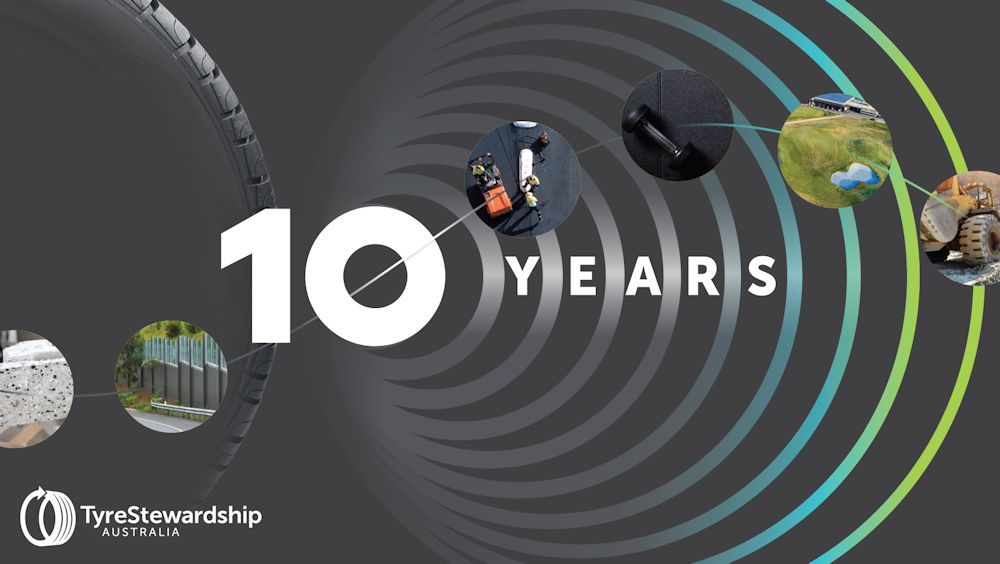Tyre Stewardship Australia expands into the next decade with more opportunities for investors, recyclers and manufacturers
The new financial year marks 10 years of operation for Tyre Stewardship Australia and sees more rubber product recycling opportunities opening up across the country than ever before.
Industry case studies show rubber product users and recyclers, in metro, regional, rural, and remote areas, are defying challenging economic times to gain value from tyre recycling.
“As Australia’s tyre product steward, we provide focused and practical pathways for government, business, and consumers to take action. And they are. They are putting in the hard yards to take us into the future,” Tyre Stewardship Australia (TSA) CEO Lina Goodman says.
“We’re seeing more innovation than ever before, and it’s all down to the stamina, staying power and will to do the right thing of those who have invested dollars, time and energy into building Australia’s circular tyre economy,” says Goodman.
There are now 16 tyre and auto brands investing in circular tyre economy outcomes for Australia, through their support of TSA.
Eight tyre brands – Bridgestone, Continental, Goodyear Dunlop, Kumho, Michelin, Pirelli, Toyo, and Yokohama – have been doing so from the early years. Now joining them in paying a levy on every tyre they sell in Australia are: Ascenso, Bearcat, Hankook, Kal Tire, Mercedes Benz, Porsche, TyreConnect, and Get A Grip Tyres.
Those contributors have made it possible for TSA to inject over $10 million directly into developing markets for tyre-derived materials and research into solutions for end-of-life tyres. These projects are critical to achieving the growth of the tyre recycling sector and across the entire value chain.
Taken together with market development funding, TSA spends around 40 per cent of its budget each year directly on its efforts to boost the recycling sector, by stimulating and expanding markets for tyre-derived material and facilitating collaboration between industry entities and with government.
“We are not going to take our foot off the pedal in seeking regulation that requires every tyre importer and auto brand to follow the strong leadership of the existing 16 tyre and auto brands which voluntarily contribute for the products they import and sell – and putting a stop to free riders in the Australian market.
“The need for an all-in scheme is amplified as we move closer to the global and domestic environment target dates Australia has signed up to, including the pathway to net zero by 2050.
“Equally amplified are the opportunities to meet those targets.
“With only 57 per cent of tyre importers and only 3 per cent of auto brands contributing, Australia’s circular tyre economy has grown from just a few pioneers driving change in 2014 to more mainstream innovation in 2024. Just imagine what we could do with 100 per cent contributing to an all-in scheme,” says Goodman.
Where are the big gains to be made in the next decade? What are the choices we can and should make now?
On reflecting on the past decade, Goodman says; “We can all acknowledge that it is not easy, or always possible, to do the right thing every time. Particularly now when cost of living is reducing household and business budgets and, ultimately, our choices.
“However, this means the choices we can and do make become more important. The lessons we have learned tell us we cannot afford to compromise sustainability – Australia must become the custodian of its own waste, or we risk having no choices in the future.
“In addition to regulating the Tyre Product Stewardship Scheme, a practical and effective choice that can be put into action now is mandating government procurement.
“We know that countries gaining the most value from the recovery of end-of-life tyres have regulatory systems in place, but also use the weight of government procurement.
“Procurement mandates that look beyond short-term tender budgets to long-term cost savings and sustainability will increase local manufacturing, jobs, and markets, and reduce environmental and social harm,” says Goodman.
The demand for circular choices is gaining momentum, but this could come to an abrupt halt if government is slow to act. By continuing to focus on the collection and processing, we are treating used tyre waste as the starting point – thwarting circular economy solutions.
We need to focus on the entire value chain with a pathway towards circular economy outcomes, and that begins with better design and manufacturing, retread, repair, and using recovered rubber back into value added products, including back into tyres.
“The development of new, higher value end markets for tyre-derived materials will open choices for investors looking to strengthen Australia’s circular economy businesses, manufacturing, and jobs.
“For 10 years we have persevered under a voluntary tyre stewardship arrangement, and it has delivered on the back of the innovation and commitment of the industries, importers, recyclers, retailers, and manufacturers committed to the cause. But it has delivered all it can,” says Goodman.
A few steps forward by government will take Australia leaps and bounds into the circular economy – with an all-in scheme and mandated procurement policies; TSA is ready to support the necessary steps.


















